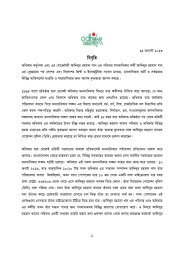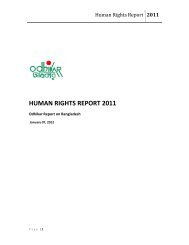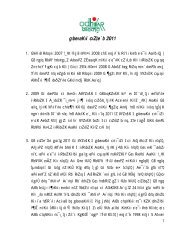Please - Odhikar
Please - Odhikar
Please - Odhikar
Create successful ePaper yourself
Turn your PDF publications into a flip-book with our unique Google optimized e-Paper software.
necessary. Such action plan calls for regional cooperation, preferably in the SAARC region.<br />
Though there is a SAARC document against trafficking, the same does not address the issue of<br />
Victim/Witness protection. Such protection is vital for prosecution as well as for giving support<br />
to victims and witnesses to depose and assist prosecution. Though instances of such prosecution<br />
is few and far, so far as cross-border trafficking is concerned, the 'South Asian Regional<br />
Initiative/Equity Support Program' (SARI/Q) in collaboration with the human rights and women<br />
rights activists of the region, are undertaking the endeavor to hammer out a regional victim -<br />
witness protection protocol for South Asia. If the protocol is adopted, social workers believe that<br />
the inherent weakness in the present prosecution system for traffickers may be reduced to some<br />
extent, if not eliminated. The summary of the proposed protocol is stated below for creating<br />
public awareness and encouraging discourse.<br />
Regional Victim/Witness Protection Protocol<br />
Even though official data are lacking in the South Asia context, it appears to be widely accepted<br />
that incidents of violence against women and children (including trafficking) have considerably<br />
increased in the last decade. Few cases are reported to the law enforcement agencies and even<br />
fewer reach the trial stage and that 15 to 20% of the accused are convicted - most cases resulting<br />
in acquittals. One of the main reasons for the low rates of complaints and convictions appears to<br />
be the reluctance of victims to come forward in filing complaints against those who have<br />
violated their rights. Or to testify in court for fear of humiliation and threat to their own life and<br />
property or that of their families. Strong legal instruments for the protection of victim witnesses<br />
are therefore needed. Women and children who are victims of crime are uniquely vulnerable to<br />
threats and intimidation, far more so than the average witness.<br />
Their human rights are violated both in the course of the crimes committed against them and in<br />
their subsequent persecution by their assailants when they attempt to do their duty as citizens<br />
and testify. Violations of human rights are both a cause and a consequence of violence against<br />
and commercial sexual exploitation of women and children. Accordingly, it is essential to place<br />
the protection of all human rights at the center of any measures taken to prevent and combat<br />
these crimes.<br />
The testimony of a victim in a crime of violence is often the best and the only evidence that can<br />
be obtained against an accused. It is therefore incumbent upon the State, in fulfillment of its duty<br />
of meting out justice, to ensure that victims who would be witnesses are protected against the<br />
threats and the intimidation, psychological and physical, of the associates of the accused. The<br />
victim-witness special status needs to be recognized. The State is best equipped to provide<br />
protection and security to victim-witnesses and thereby protect their human rights.<br />
Currently, neither India, Bangladesh, Nepal or Sri Lanka have a distinct law, policy, guidelines<br />
or programs to protect victim -witnesses before, during or after the trial. Though some existing<br />
laws (penal codes, criminal procedure codes and constitutions) refer to witness protection,<br />
provisions appear to be insufficient to adequately protect women and children victim - witnesses<br />
who have been trafficked for sexual exploitation.<br />
There is thus a need for a more rights based regional protocol to combat violence against and<br />
commercial sexual exploitation of women and children in South Asia and to protect and promote<br />
Report 2005<br />
193











